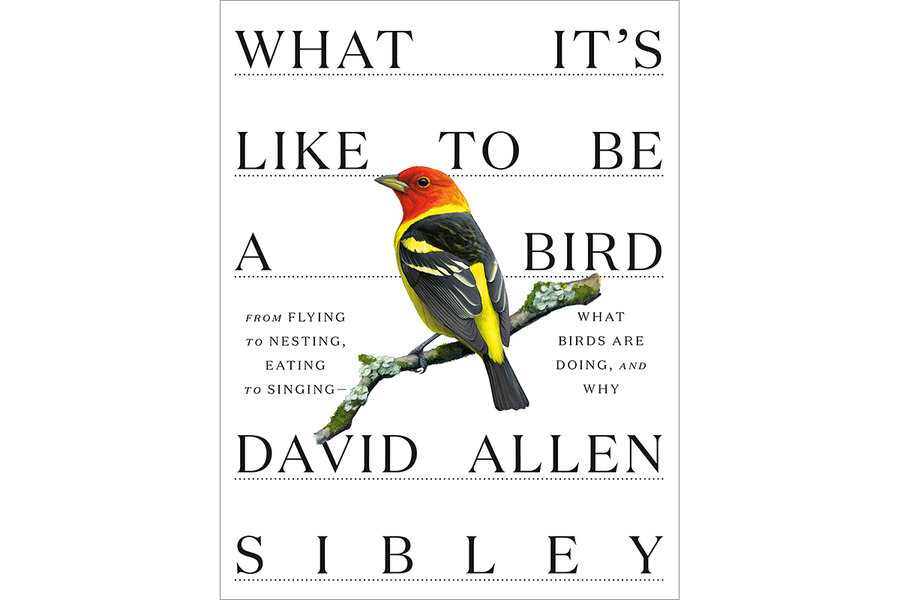What are birds doing? David Allen Sibley knows.
Loading...
Many of us have been homebound this spring, which sharpens the joy of backyard birdwatching. In a season too often defined by isolation, the arrival of a cardinal or blue jay just beyond the window is a hopeful reminder of continuity and connection. Even in the midst of our current troubles, it seems, nature carries on.
It’s in this spirit that “What It’s Like to Be a Bird: From Flying to Nesting, Eating to Singing – What Birds Are Doing, and Why,” David Allen Sibley’s new primer on all things ornithological, is likely to find an especially receptive audience right now. Sibley is best known for the series of bird guides he launched in 2000. Like others in the genre, the Sibley guides are small enough to slip into a coat or knapsack. But “What It’s Like to Be a Bird” is a big coffee table book meant for indoors. An afternoon with this sprawling volume on my lap was a lovely way to tolerate a day of social distancing.
The other plus is seeing Sibley, a bird artist as well as a writer, work on a larger scale. Like the late naturalist Roger Tory Peterson, whose field guides defined American ornithology for generations, Sibley has an exacting eye for detail. But to accommodate the miniature format of his identification manuals, Sibley’s bird pictures are usually not much bigger than a postage stamp.
“What It’s Like to Be a Bird,” though, gives Sibley’s artwork ample room to spread its wings. The heads of his snow geese, swans, and ducks seem to approximate life-size, each one rendered in Sibley’s signature gouache technique, a variation of watercolor that shimmers with radiant color. Sibley, like John James Audubon, is especially drawn to the faces of birds, and in his renderings, as in Audubon’s, they look almost human. His roadrunner, dining cheerfully on a lizard, seems as familiar to us as a fellow customer at a neighborhood diner. Sibley’s kingfisher, perched in a posture of expectation on a branch, reminded me of a child waiting for a school bus.
In hinting at human qualities in his birds, is Sibley reflecting reality or distorting it? It’s a question he puts at the center of “What It’s Like to Be a Bird,” which argues that while birds aren’t people, they might be closer to us in the way they think and feel than we often assume. “One of the themes that impressed me ... is that a bird’s experience is far richer, more complex, and more ‘thoughtful’ than I’d imagined,” he tells readers.
“Birds are making decisions all the time,” Sibley notes. In building nests, for example, they appear guided not only by instinct, but by an intelligence actively navigating a range of choices. “The chickadee that flies to your birdfeeder and grabs a seed is making choices about which seed to choose, and whether to hide or eat it.”
Originally conceived as a book for children, “What It’s Like to Be a Bird” was eventually reimagined to reach readers of all ages. Happily, its ideal of simplicity remains intact. Unlike “The Sibley Guide to Bird Life and Behavior,” a 2001 work that was encyclopedically dense, this new book is a breezy read. It can be dipped into casually, lively facts alighting like sparrows on every page.
We learn, for instance, that birds lose 10% of their body weight each night. “If you ‘ate like a bird,’” Sibley writes, “you might eat more than twenty-five large pizzas each day.” Because water refraction distorts the location of fish, much as a pencil in a glass of water looks bent, egrets must use a complicated stance to correct for the illusion when hunting prey. Doves and pigeons don’t bob their heads because they’re goofy; the head movement is synchronized with their gait to help keep their vision fixed on what they have to see. Birds have another clever trick. “Bird sleep is quite different from ours,” Sibley writes, “and they can put half of their brain to sleep while continuing activity with the other half.”
Should an insight in “What It’s Like to Be a Bird” seem worth revisiting, be sure to bookmark it. Inexplicably, the book has no standard index, which limits its use as a reference work. Maybe that’s forgivable, since the abiding impulse of “What It’s Like to Be a Bird” leans toward pleasure rather than practical application.
In a spring shadowed by the darker mysteries of nature, Sibley’s book is a welcome occasion to connect with the more pleasing puzzle of what our feathered friends are up to. We’ll probably never know exactly what it’s like to be a bird, which is part of their inexhaustible appeal.








